The Vibrant History and Enduring Beauty of Mexican Architecture: A Cultural Journey
Mexican architecture is a captivating tapestry woven from centuries of diverse influences, telling remarkable stories through its distinct colors, intricate shapes, and innovative designs. From the awe-inspiring ancient temples that pierce the sky to the vibrant, modern homes that dot bustling cities, the architectural landscape of Mexico masterfully blends the old with the new in ways found nowhere else on Earth. This unique fusion creates an experience that is both deeply rooted in history and dynamically forward-looking.
There’s an undeniable magic that washes over you when you witness the brilliant hues of Mexican buildings standing proudly against the country’s often clear, blue skies. These structures are more than just constructions of stone and mortar; they are living expressions of Mexico’s soul. They seamlessly integrate indigenous wisdom, passed down through generations, with the sophisticated ideas brought by Spanish colonizers, forging a truly authentic and unmistakable Mexican aesthetic. This profound blend is what makes Mexican architecture so compelling and globally celebrated.
What resonates most profoundly is how these buildings lay bare the very heart of Mexico—a heart that is warm, unapologetically bold, and brimming with life. When you immerse yourself in Mexican architecture, you’re not merely observing walls and roofs; you’re delving into the nation’s profound spirit, its epic past struggles, its unwavering resilience, and its boundless hopes for the future. Each arch, every mosaic, and vibrant facade whispers tales of tradition, innovation, and an unyielding connection to culture. Join us as we embark on a fascinating journey through the most beautiful and iconic buildings Mexico has to offer!
Key Architectural Features Defining Mexican Design
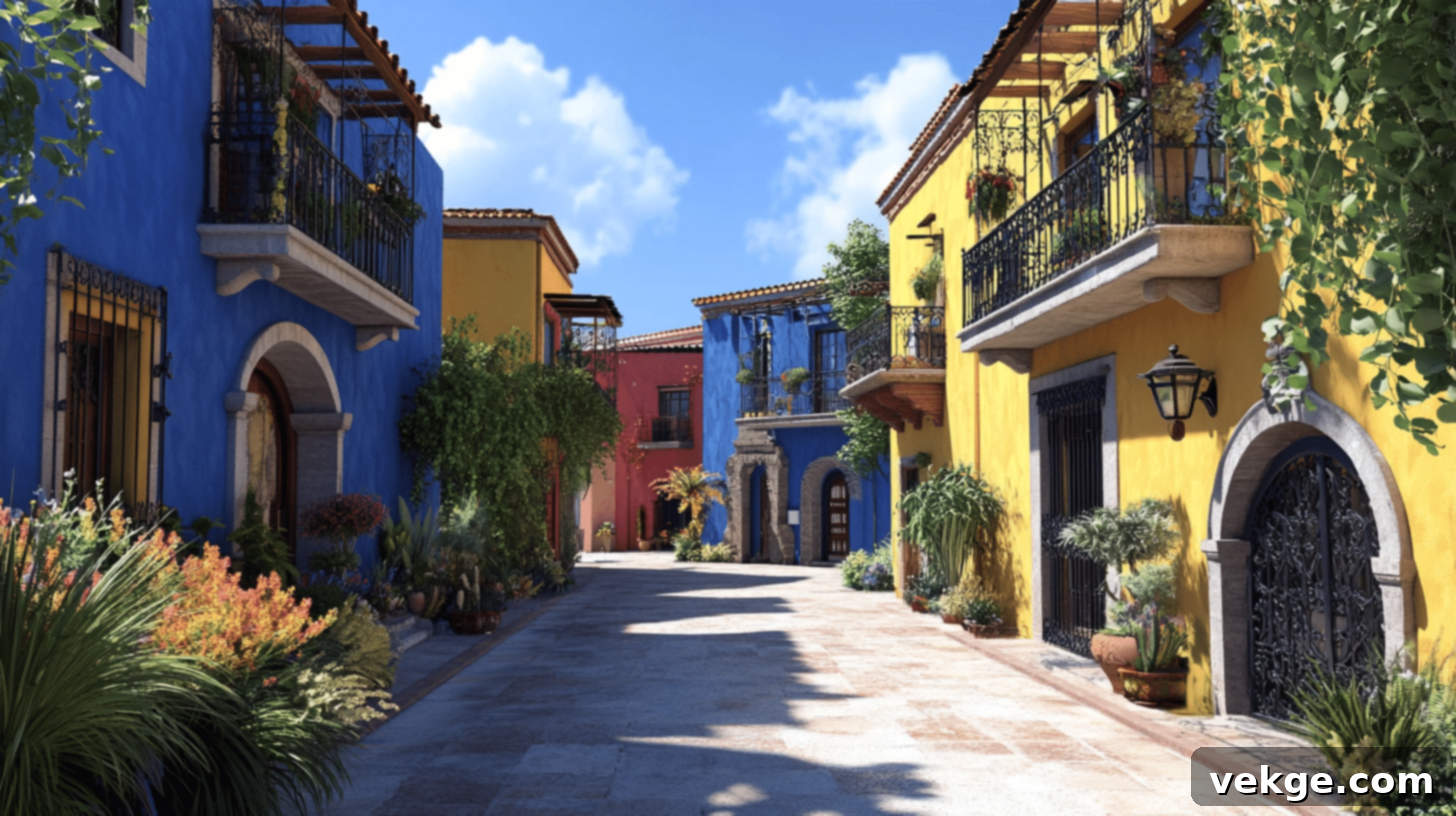
Use of Vibrant Color
Mexican architecture explodes with an unparalleled palette of colors, practically bursting at its seams. From the striking fuchsia and turquoise plastered walls of charming homes to the radiant sunshine-yellow facades of historic churches, these bold and often unexpected chromatic choices beautifully reflect the country’s joyful spirit and deep cultural pride. The application of color is not merely decorative; it’s a narrative, telling stories of ancient traditions, sacred symbols, and exhilarating modern creativity. Walking through a Mexican city is an experience for the senses, where every corner reveals a new burst of visual energy.
- Cultural Significance: Colors in Mexican buildings are deeply intertwined with ancient Aztec and Mayan symbols, rich Catholic traditions introduced during the colonial era, and the stunning natural landscape. For example, specific shades of blue may echo the sky god, while earthy reds connect to the land.
- Emotional Impact: The sheer vibrancy of Mexican streets has a profound uplifting effect. It energizes the soul, stimulates creativity, and creates an inviting, festive atmosphere that is uniquely Mexican.
- Modern Interpretations: Contemporary architects continue to innovate with color, finding fresh and exciting ways to use bold palettes while respectfully honoring the deep historical roots and symbolism of the past.
- Regional Diversity: Color palettes vary significantly across Mexico’s diverse regions. Northern desert towns might favor more muted earth tones accented with bright pops, while tropical southern regions embrace lush greens, deep blues, and brilliant yellows that mirror their natural surroundings.
Intricate Carvings and Ironwork
The exquisite detailing found in Mexican buildings is often so compelling that it will literally stop you in your tracks. Highly skilled craftspeople, whose talents have been honed over generations, dedicate countless hours to meticulously carving stone, wood, and metal, transforming raw materials into true works of art. These handcrafted touches infuse every building with a unique personality, a sense of history, and an undeniable warmth that mass-produced elements can never replicate.
- Religious and Mythological Motifs: Church facades, in particular, are renowned for their elaborate carvings featuring saints, angels, biblical scenes, and a fascinating array of natural motifs, all lovingly sculpted by hand. Many also subtly incorporate pre-Columbian symbols, a testament to cultural fusion.
- Functional Beauty: Wrought iron balconies, ornate gates, and elegant window grilles are not only stunning decorative elements but also serve practical purposes, offering security and controlling light while adding immense beauty and intricate patterns to the building’s exterior.
- Timeless Woodworking: Doors, ceiling beams, and furniture often showcase incredible woodworking skill, featuring complex geometric patterns, floral designs, and narrative carvings passed down through master-apprentice relationships for centuries.
- Stories in Stone: Many carvings go beyond mere aesthetics, serving as visual chronicles that narrate stories from local history, religious texts, or beloved indigenous legends, making the buildings themselves powerful storytellers.
Courtyards, Arcades, and Thick Walls
Mexican buildings are expertly designed to create their own serene worlds within. Central courtyards, known as ‘patios,’ are a cornerstone of this design philosophy, bringing vital elements of nature, abundant natural light, and refreshing fresh air into the very heart of both private homes and grand public buildings. These thoughtfully integrated spaces foster connection—between people, between interior and exterior, and with the natural environment.
- Outdoor Living: Courtyards often transform into inviting outdoor living rooms, serving as vibrant social hubs where families gather, meals are shared, and cherished memories are made amidst lush greenery and tranquil fountains.
- Climate Control: The characteristic thick walls, typically constructed from adobe, stone, or brick, provide exceptional thermal mass, keeping interiors wonderfully cool during hot days and retaining warmth on chilly nights. Shaded arcades and deep verandas further enhance comfort by blocking direct sunlight.
- Seamless Transition: Mexican design beautifully blurs the line between inside and outside, creating a harmonious flow that allows inhabitants to enjoy the pleasant climate and natural surroundings from nearly every part of the building.
- Privacy and Community: These architectural features ingeniously balance the need for personal sanctuary and privacy with opportunities for social interaction and a strong sense of community. The enclosed courtyard offers a private haven, while its central location makes it a natural gathering point.
Local Materials and Sustainability
Long before the concept of “sustainability” became a global buzzword, Mexican builders inherently embraced environmentally conscious practices. Their intelligent approach involved utilizing readily available local materials, resulting in structures that not only belonged organically to their surroundings but were also built to stand resiliently against the test of time, weather, and changing trends for centuries.
- Natural Regulation: Sun-dried adobe brick and rammed earth walls are prime examples, naturally regulating interior temperatures without mechanical means, making them incredibly energy-efficient.
- Enduring Stone: Volcanic stone, readily abundant in many regions, has been a foundational material, appearing in everything from ancient pyramids and grand colonial cathedrals to sleek, minimalist modern homes.
- Rich Woodwork: Indigenous woods like pine, cedar, and various tropical hardwoods are prized for their durability, beauty, and ability to bring natural warmth and unique character to interiors and structural elements.
- Passive Design: Traditional designs often incorporate sophisticated passive cooling methods, such as strategic window placement for cross-ventilation, open courtyards that create convection currents, and systems for rainwater harvesting, showcasing an innate understanding of environmental harmony.
Iconic Structures to Visit for Architectural Inspiration
Mexico is home to countless architectural marvels that span millennia. Here are a few must-visit examples that showcase the breadth and depth of the country’s design legacy:
- Ciudad Universitaria (UNAM): A UNESCO World Heritage site, this massive university complex in Mexico City is a masterpiece of mid-20th-century modernism, famous for its monumental murals by Diego Rivera and Juan O’Gorman.
- Museo Jumex: Located in Mexico City, this striking contemporary art museum, designed by David Chipperfield, features a saw-tooth roof and a distinctive travertine facade, a beacon of modern design.
- Casa Gilardi: One of Luis Barragán’s most celebrated works, this private residence in Mexico City is a vibrant, minimalist sanctuary, renowned for its manipulation of light, water, and saturated color.
- Revolution Monument (Monumento a la Revolución): An iconic landmark in Mexico City, this colossal structure combines Art Deco and Mexican nationalist styles, serving as both a mausoleum and a symbol of national identity.
- Nido de Quetzalcóatl (Quetzalcoatl’s Nest): A fantastical example of organic architecture by Javier Senosiain, this unique apartment complex near Mexico City is shaped like a giant serpent, blending seamlessly with its natural surroundings.
The Foundations: Pre-Columbian Architecture

Long before the arrival of Europeans, Mexico’s native peoples engineered and constructed astonishing structures that continue to captivate and astound us today. These early builders were not merely erecting buildings; they were creating entire cities that mirrored the cosmos, meticulously aligning their constructions with celestial bodies, and inscribing their rich histories and spiritual beliefs directly into stone. Their architectural legacy is a powerful testament to advanced knowledge, sophisticated mathematics, and profound artistry.
Mayan Architecture: Celestial Pyramids and Sacred Cities
The Maya civilization, known for its intellectual prowess, built magnificent tall pyramids that seemingly reach for the sky at renowned sites like Chichen Itza and Palenque. When you stand at the base of these massive stone wonders, you can’t help but feel incredibly tiny, yet deeply connected to a powerful ancient world. It’s truly astonishing to consider that they constructed these monumental edifices using precisely cut limestone blocks, all without the aid of metal tools or the wheel, relying instead on sheer ingenuity and immense collective effort.
I am perpetually amazed by the Maya’s profound astronomical knowledge, evident in how precisely they aligned their buildings with the sun, moon, and stars. During specific solstices and equinoxes, light and shadow play across the carved stones in magical, precisely calculated ways, revealing intricate serpent forms or illuminating specific chambers. These phenomena demonstrate the extraordinary intelligence and spiritual depth of these ancient architects, who designed their cities to interact with the heavens.
Aztec Architecture: Urban Marvels and Ceremonial Centers
The powerful Aztec empire built its magnificent capital city, Tenochtitlan, on an island in the middle of a lake, a true engineering marvel featuring an intricate network of canals that served as streets and waterways. Their towering Great Pyramid, or Templo Mayor, once stood proudly at the heart of what is now modern-day Mexico City, a testament to their dominance and religious devotion.
When you walk through archeological dig sites such as Teotihuacan, with its colossal Pyramids of the Sun and Moon, you are not just traversing ancient ground; you are stepping into the very places where ancient people lived, worshipped, and conducted their daily lives. The Aztecs, like other Mesoamerican cultures, built primarily with local stone, viewing their awe-inspiring buildings as essential links to their pantheon of gods and the vast, mysterious cosmos above, intertwining architecture with cosmology and spirituality.
Spanish Colonial Influence: A New World of Design

With the arrival of the Spanish in Mexico, a profound shift in architectural trends began. They brought with them European building traditions and aesthetic principles, which then mingled with existing indigenous construction methods and artistic expressions. This dynamic mix of old and new fundamentally shaped the distinctive look of Mexican buildings we admire across the country today, leading to a rich and complex architectural identity that is uniquely hybrid.
Origins of Hacienda Style: Grand Estates and Self-Sufficient Worlds
Spanish settlers began constructing large country estates, known as haciendas, as early as the 16th century, though they flourished in the 17th and 18th centuries. These were far more than simple houses; they were sprawling, self-sufficient compounds, functioning almost like small towns where agricultural production, processing, and domestic life seamlessly intertwined. Haciendas were the economic and social backbone of rural Mexico for centuries, representing wealth, power, and a distinct way of life.
Wealthy owners sought not only comfort and elegance but also demanded highly practical and defensible buildings for their vast enterprises. You can still visit many of these beautifully preserved old estates today, often converted into luxury hotels or museums, and experience firsthand the grand scale and enduring charm of hacienda life, feeling the echoes of a bygone era.
Key Elements of Colonial Architecture: Functionality Meets Beauty
Colonial buildings were masterfully designed to remain cool and comfortable in Mexico’s often hot climate, primarily thanks to their remarkably thick walls. These substantial barriers, typically made of adobe or stone, provided excellent insulation. The iconic clay roof tiles, a hallmark of colonial design, were strategically laid to allow hot air to escape, ensuring comfortable interiors even without the luxury of air conditioning.
You’ll frequently notice small windows, often protected by elegant iron bars – a design choice that served both to keep homes secure and to help regulate indoor temperatures by minimizing direct sunlight penetration. When you pass through a grand wooden doorway, often adorned with intricate carvings and situated beneath beautifully rounded arches, the exposed wooden beams above serve as a powerful reminder of the exceptional craftsmanship and enduring construction techniques from centuries ago.
Tequitqui Style: A Harmonious Cultural Fusion
Within the intricate details of colonial churches, you will often spot a fascinating and unique architectural style known as Tequitqui. This refers to carvings and artistic elements that ingeniously blend Spanish religious iconography with indigenous Mexican symbols and artistic sensibilities. It’s a truly special style, serving as a powerful visual testament to how two distinct cultures began to converge and create something entirely new and profound.
These wonderfully blended designs narrate the complex story of indigenous artisans finding subtle yet powerful ways to preserve and express their own rich cultural heritage, even while adapting to the new artistic and religious dictates imposed by their Spanish conquerors. Each Tequitqui carving holds valuable clues about this intricate and transformative period in Mexican history, offering insights into cultural resilience and artistic syncretism.
Churches and Cathedrals: Pillars of Faith and Artistry
The first Spanish monks constructed relatively simple churches, but over time, as colonial wealth grew, these structures evolved into increasingly elaborate and magnificent edifices. The grand cathedrals found in major cities became showcases of opulent Baroque and Neoclassical styles, adorned with lavish details, intricate gold leaf, and stunning frescoes that demonstrated both religious devotion and colonial power.
Mexico City’s Metropolitan Cathedral, a monumental structure, is a prime example of this evolution, having taken an astounding 250 years to complete. When you step inside, it’s worth taking a moment to gaze up at the ceiling – each part reflects different architectural styles and construction periods, a visual timeline of its extensive history. Similarly, the charming churches in picturesque towns like San Miguel de Allende or Puebla blend Spanish grandeur with distinctive local touches, such as colorful Talavera tiles, making them feel intrinsically and wonderfully Mexican, embodying the unique fusion that defines the nation’s architectural identity.
The Rise of Mexican Baroque (Churrigueresque): A Flourish of Ornamentation
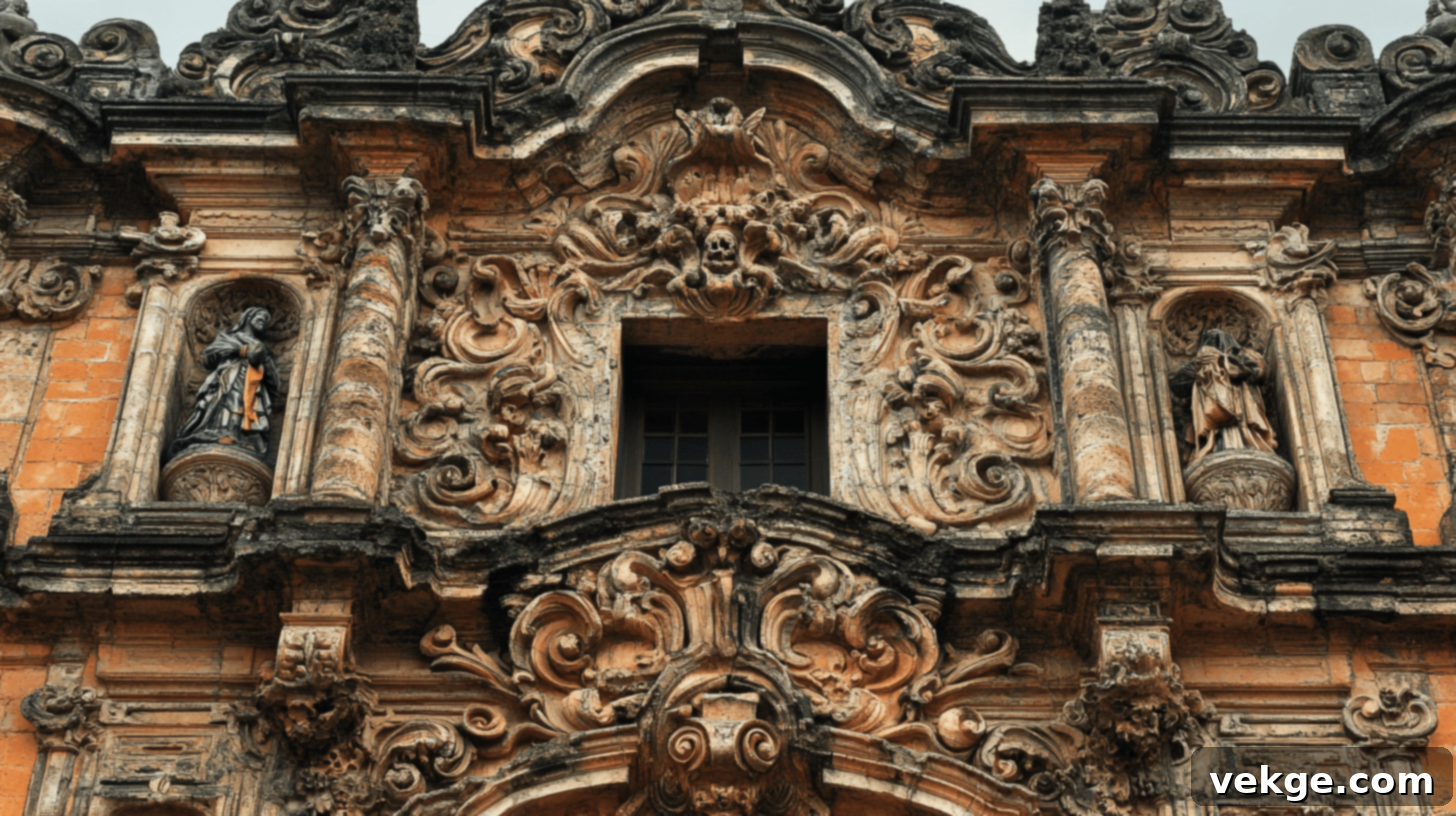
As Mexico began to forge its distinct cultural identity during the colonial era, its buildings, particularly churches, developed an extraordinary level of ornamentation. The Mexican Baroque style, often reaching its zenith in the Churrigueresque variant, vividly illustrates how local artists and artisans infused European ideas with their own unique flair, creating something far grander and more expressive than its Iberian counterparts. This period marked a powerful assertion of a burgeoning Mexican artistic voice, translating spiritual fervor into dazzling architectural displays.
These opulent buildings are designed to absolutely drop your jaw with their astonishing level of detail and dramatic sculptural forms. Nearly every inch of their facades is covered with an exuberant array of carvings—twisted columns, elaborate floral motifs, playful cherubs, and complex geometric patterns that seem to twist and turn, telling intricate stories in stone. The primary goal of these intensely decorated frontispieces was to command attention, draw the eye heavenward, and evoke a sense of overwhelming wonder and divine presence.
You’ll find some of the most spectacular examples of this style in places like the Church of Santa Prisca and San Sebastián in Taxco, a town where wealthy silver miners spared no expense on a church that literally sparkles with creative energy and intricate detail. In cities like Puebla and Oaxaca, colonial buildings adorned with vibrant Talavera tiles and elaborate stucco work seem to come alive with a sense of movement, texture, and an explosion of color, demonstrating the distinctive regional interpretations of this grand style. Mexican artists were not merely replicating European forms; they were masterfully transforming them into something uniquely resonant with their own cultural sensibilities and spiritual passions, creating works that spoke directly from their hearts.
Hacienda Style: Rural Elegance and Enduring Legacy
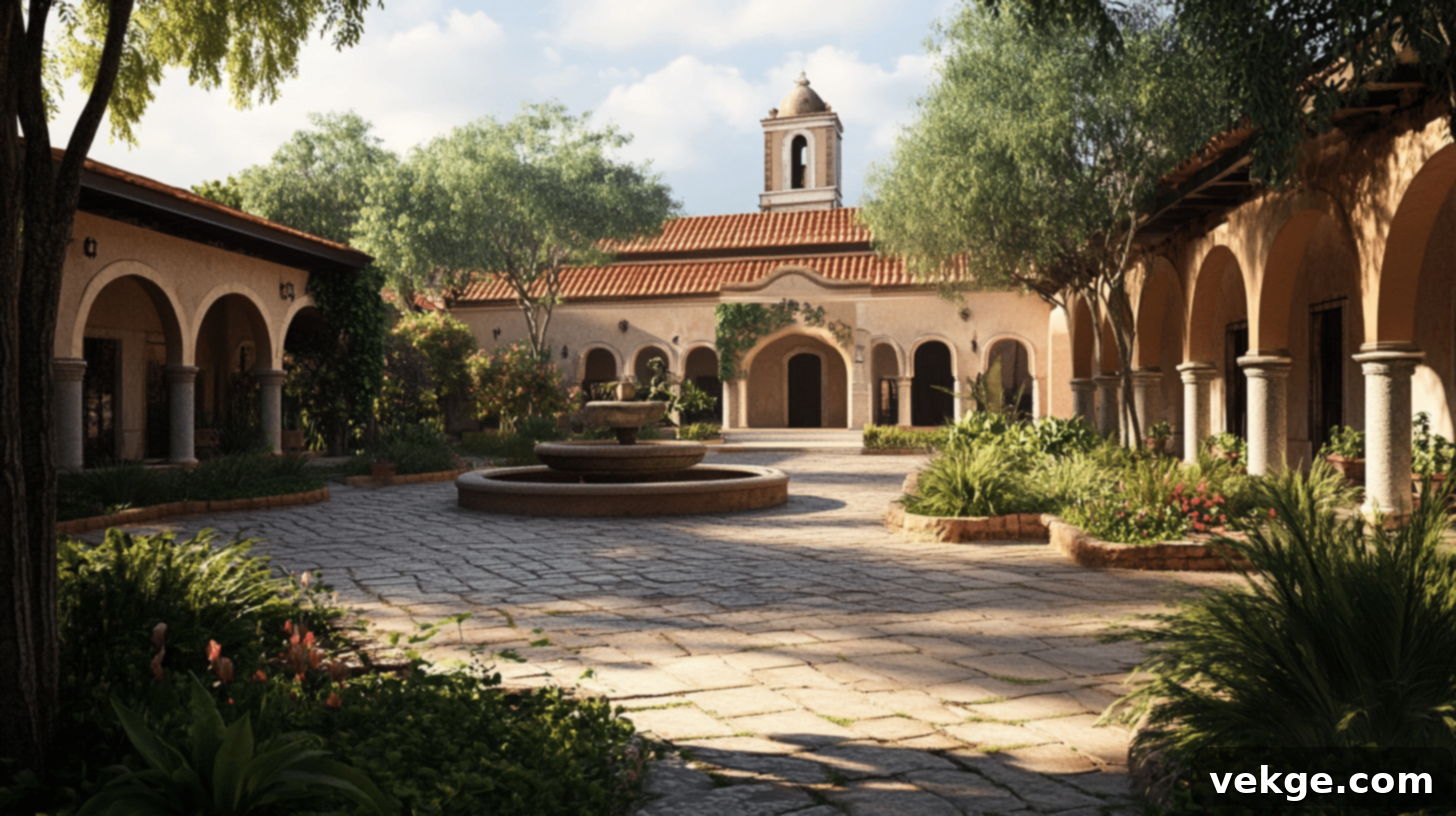
The vast countryside homes of Mexico, known as haciendas, stand as profound testaments to how Mexicans historically blended practical functionality with exquisite beauty. These grand estates represent a pivotal era when land was the ultimate measure of wealth and power, and homes were meticulously constructed to endure for countless generations. They were self-sufficient economic units, encompassing not just residences but also chapels, workshops, and extensive agricultural lands, forming complex mini-societies.
Layouts, Materials, and Enduring Legacy
Haciendas were typically organized around one or more open courtyards, or patios, serving as the social and functional heart of the estate where families could enjoy fresh air, privacy, and shelter from the elements. Thick, robust walls, often constructed from local stone, adobe, or brick, were essential for keeping rooms remarkably cool during the scorching days and comfortably warm throughout the cooler nights. These materials provided excellent thermal regulation long before modern air conditioning.
Water features, such as fountains and irrigation channels, were not merely decorative; they were crucial for farming, livestock, and daily life, symbolizing prosperity and life itself. The earthy, natural colors of these buildings—often shades of ochre, terracotta, and warm whites—harmoniously blend with the surrounding landscape, giving the impression that they grew organically from the very soil of Mexico. Many haciendas have been beautifully restored, now serving as boutique hotels or event venues, allowing their rich history and architectural grandeur to be appreciated by new generations.
Influence on Modern Southwestern U.S. Architecture
The architectural impact of the Mexican hacienda extends far beyond its borders. If you look closely at homes and public buildings across the Southwestern United States, particularly in states like Arizona, New Mexico, and California, you’ll discover unmistakable hacienda touches everywhere. The ubiquitous red tile roofs, elegant arched doorways, shady verandas, and tranquil inner courtyards are all direct design legacies that traveled north from Mexico.
This enduring style feels inherently right and perfectly adapted to the hot, arid climates of the American Southwest, proving its timeless effectiveness and aesthetic appeal. It represents a living connection to the shared history and cultural exchange between Mexico and its northern neighbors, continuously inspiring architects and homeowners alike.
20th Century and Modern Styles: Mexico’s Evolving Identity
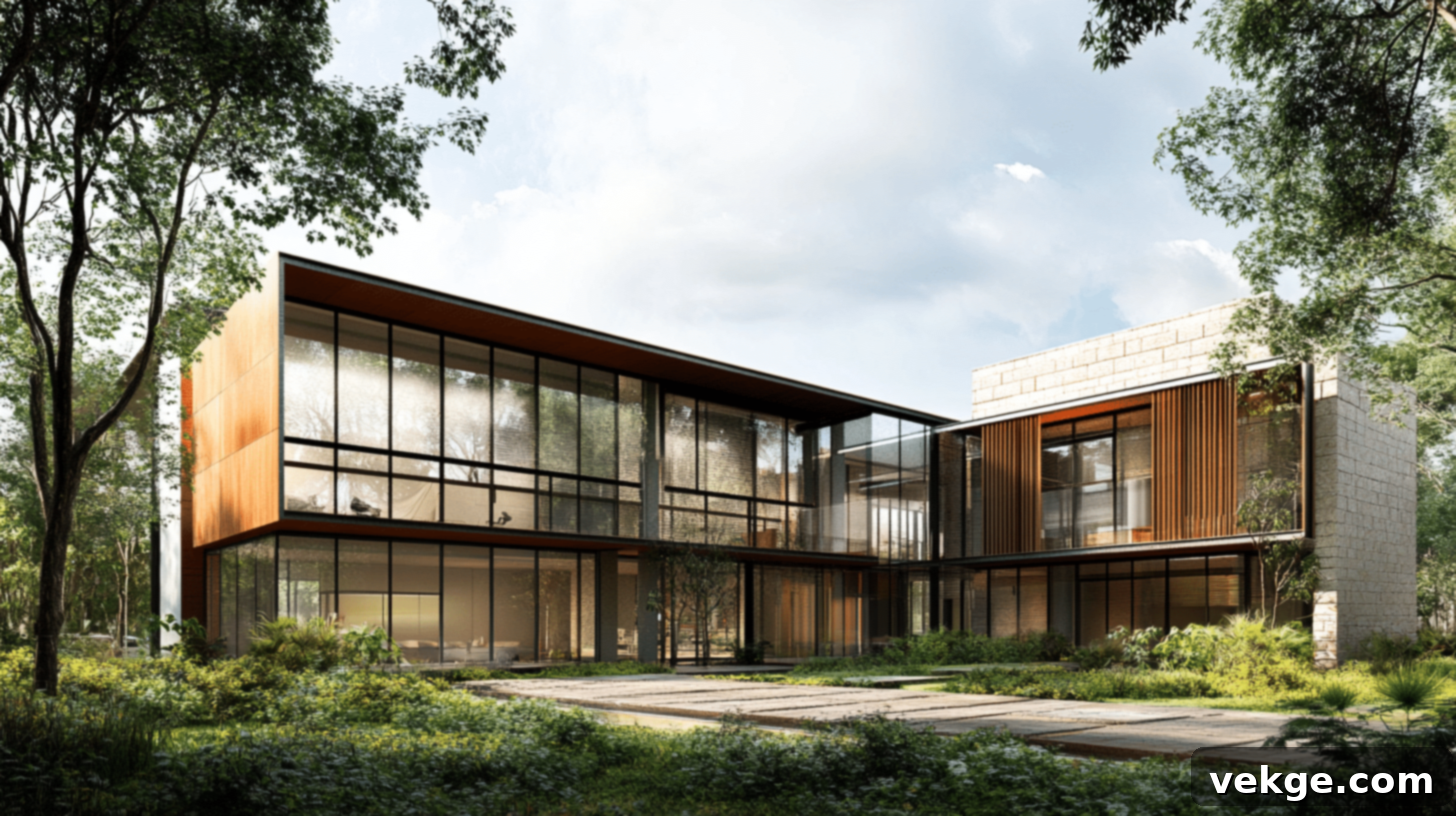
As Mexico transitioned into the 20th century and embraced modernity, its architectural expressions transformed significantly. Architects began experimenting with groundbreaking new ideas and materials while consciously retaining essential elements and a distinctive “Mexican” sensibility from the nation’s rich past. These newer styles are powerful indicators of Mexico’s burgeoning growth as a sovereign nation, asserting its unique place on the global stage of design and culture.
Neo-Colonial and Art Deco Movements: A Look Back and a Step Forward
In the early 1900s, coinciding with the post-Revolutionary search for national identity, Mexican architects looked back to their colonial past with renewed appreciation, giving rise to the Neo-Colonial movement. Buildings from this era often featured cleaner lines and simplified forms but consciously retained familiar elements like graceful arches, intricate ironwork, and enclosed courtyards. It was a romanticized homage to a foundational period in Mexican history.
Simultaneously, the vibrant, geometric aesthetics of Art Deco arrived, bringing a fresh, international dynamism to Mexican cities. You can still walk through neighborhoods like Roma and Condesa in Mexico City and marvel at these “jazzy” buildings with their strong, rectilinear lines, stylized floral motifs, and fun, playful details, marking a definitive embrace of modern international trends adapted to a Mexican context.
Functionalism, Brutalism, and Minimalism: Efficiency and Form
Following the mid-20th century, particularly after the 1940s, a strong emphasis on utility and efficiency shaped many Mexican buildings. Functionalism prioritized purpose over ornamentation, leading to designs that were stripped-down and highly practical. This evolved into Brutalism, where raw concrete and massive, sculptural forms became common, often seen in public buildings and university campuses like Ciudad Universitaria.
Even when employing basic shapes and industrial materials, Mexican designers found innovative ways to inject warmth, textural richness, and a unique character into these seemingly austere styles, making them feel inviting and distinctly “at home” in the Mexican landscape. Minimalism, too, found its voice, emphasizing clean lines, open spaces, and a profound respect for natural light and materials, often echoing the simplicity of pre-Columbian forms.
Transition into Global and Postmodern Influences: A Dialogue Across Time
Today’s Mexican buildings are a sophisticated blend of global architectural trends and deep-seated local influences. Sleek glass towers and innovative skyscrapers stand in dramatic juxtaposition near ancient pre-Columbian pyramids and venerable colonial structures, visually demonstrating how Mexico effortlessly bridges its profound past with its ambitious future. This juxtaposition creates a dynamic and visually stimulating urban fabric.
What truly moves and inspires is observing how Mexican designers consistently discover ingenious ways to take global architectural movements and imbue them with a distinct local flavor and a deeply personal touch. They don’t merely copy; they interpret, adapt, and transform, ensuring that even the most contemporary structures resonate with Mexico’s unique cultural narrative and spirit, making them instantly recognizable as Mexican.
Contemporary Mexican Architects: Shaping the Future
Mexico continues to be a hotbed of architectural innovation, with a new generation of visionaries building upon the rich legacy of the past. These contemporary architects are gaining international recognition for their unique approaches, often blending modern aesthetics with traditional Mexican sensibilities and a strong commitment to sustainability and social impact.
Luis Barragán: The Master of Emotion and Color
Luis Barragán, a true icon of 20th-century architecture, crafted spaces that profoundly touch the soul. His work is instantly recognizable for its bold use of vibrant pinks, deep blues, and radiant yellows, meticulously chosen to reflect Mexico’s cultural heart and the country’s dazzling natural light. Barragán was a master at blending austere modernism with Mexican traditions, integrating elements like water, light, and carefully framed views to create serene, almost spiritual, environments.
His groundbreaking approach earned him the prestigious Pritzker Architecture Prize in 1980, firmly placing Mexican architecture on the global stage. His own home and studio in Mexico City, now a UNESCO World Heritage site, serves as the ultimate showcase of his genius and remains his greatest, most intimate legacy, offering a deep insight into his philosophy of emotional architecture.
Tatiana Bilbao: Socially Conscious and Environmentally Respectful
Tatiana Bilbao is a leading voice in contemporary Mexican architecture, known for seamlessly integrating social awareness with stunning, practical design. Her studio is particularly recognized for creating innovative, affordable housing solutions that are not only beautiful but also highly livable and culturally appropriate for the communities they serve. Bilbao actively champions the idea that good design should not be exclusive or prohibitively expensive, but accessible and empowering.
Her work consistently responds to real human needs while demonstrating a profound respect for the natural environment. Her buildings frequently utilize local, sustainable materials and are thoughtfully designed to work in harmony with the surrounding landscape and climate, embodying a forward-thinking approach to responsible architecture.
Javier Senosiain: Organic Architecture and Biomorphic Forms
Javier Senosiain is a pioneer of “organic architecture,” creating extraordinary buildings that appear to literally grow from the earth itself. His designs draw direct inspiration from natural forms – the elegant curves of shells, the delicate patterns of flowers, and the fluid shapes of animals. His signature curved walls, flowing spaces, and natural material palettes mimic the organic shapes and patterns found in nature, inviting occupants into a truly immersive experience.
Bright colors and unexpected, playful shapes make his spaces joyful, surprising, and profoundly unique. Walking through his creations, such as the famous “Nido de Quetzalcóatl,” feels like stepping into another world, a fantastical realm where architecture and nature become one. Plants, natural light, and the integration of the landscape are not merely decorative but essential, foundational elements in all of his captivating designs.
Alberto Kalach: Envisioning a Greener Urban Future
Alberto Kalach is an architect with a grand vision for Mexico City: a greener, more livable metropolis. His buildings often integrate nature directly into dense urban spaces through innovative designs that incorporate lush gardens, open-air courtyards, and strategic green elements. Kalach is dedicated to integrating plants, water, and fresh air into highly populated city environments, creating urban oases.
He fundamentally believes that architecture has the power to heal the environment rather than harm it, promoting designs that enhance ecological balance. His iconic Vasconcelos Library, a monumental structure in Mexico City, beautifully combines books, sprawling gardens, and contemporary art, demonstrating his philosophy. Kalach also deeply respects and actively updates traditional Mexican building methods to address today’s pressing needs, and his visionary plans for restoring Mexico City’s ancient lake system inspire immense hope for a sustainable urban future.
Emerging Studios: A New Wave of Mexican Creativity
A dynamic new generation of Mexican architectural studios is rapidly gaining international attention, bringing fresh perspectives and innovative solutions. Firms like PPAA (Pérez Palacios Arquitectos Asociados) and Taller Héctor Barroso are particularly noteworthy for their ability to blend deep-seated local traditions with cutting-edge ideas, creating buildings that manage to feel both timelessly classic and strikingly contemporary.
PPAA’s Minimal Beauty
Known for their clean, simple forms and honest use of materials, PPAA creates serene, minimalist modern spaces that emphasize natural light and quiet elegance. Their work often feels calm and deeply integrated with its surroundings.
Taller Héctor Barroso: Light, Shadow, and Texture
Taller Héctor Barroso’s residential projects are celebrated for their distinctive earth-toned palettes, their masterful manipulation of light and shadow, and their sophisticated celebration of natural textures. They create introspective and warm environments that connect deeply with the Mexican landscape.
These emerging studios frequently utilize a refined palette of concrete, wood, and stone, applying these foundational materials in sophisticated and unexpected ways to craft distinctly modern yet profoundly contextual architecture.
Modern Design Inspired by Tradition: A Sustainable Future
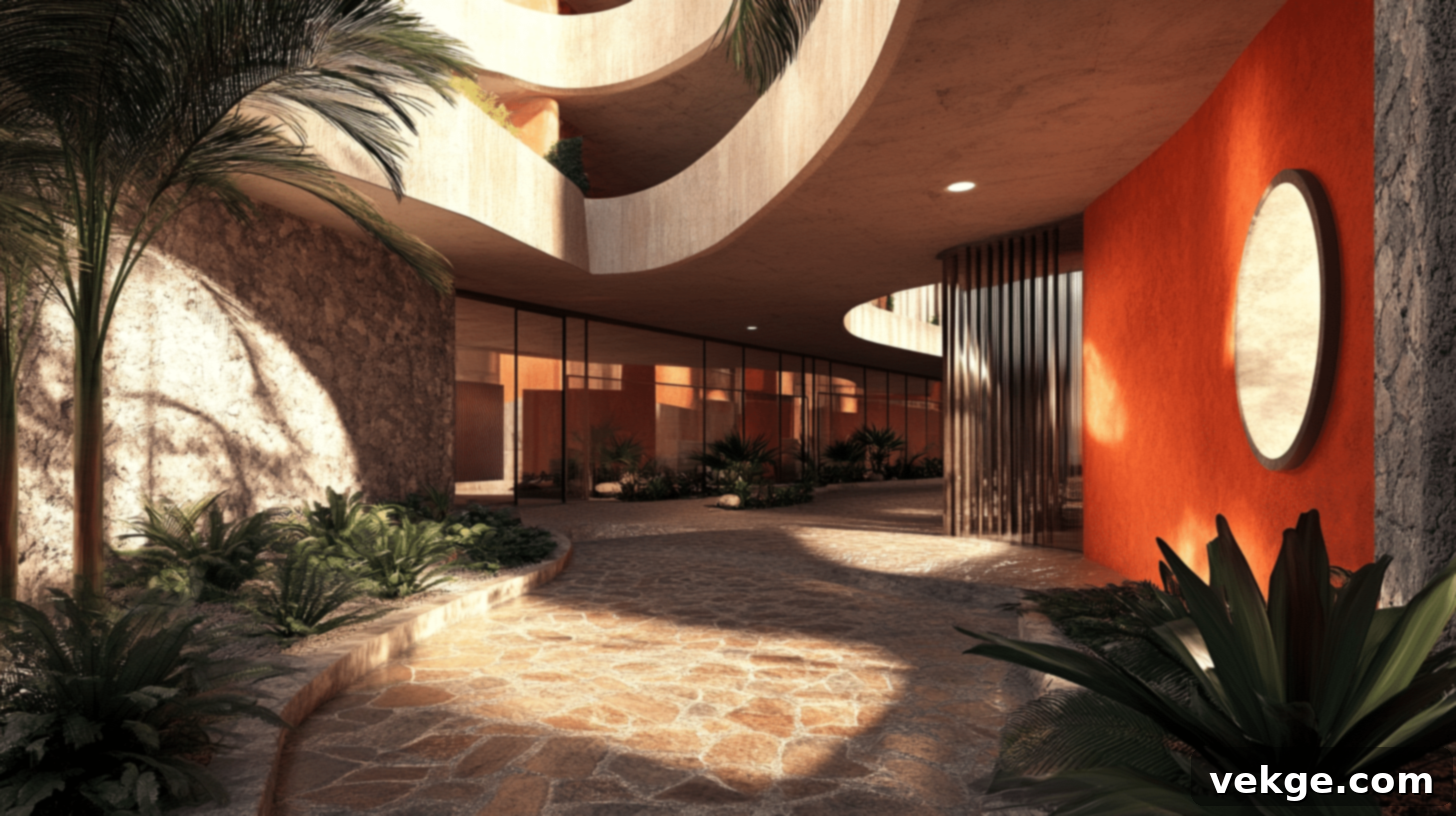
Mexican architects today are engaged in something truly remarkable. They are expertly drawing upon the very best ideas, techniques, and aesthetic principles from their rich architectural past and breathing new life into them within strikingly modern buildings. It’s as if they are conducting a profound conversation across time, meticulously listening to the wisdom of their ancestors—what worked, what endured, what brought beauty—while simultaneously innovating to solve the complex challenges of the 21st century. This dialogue between past and present defines the cutting edge of contemporary Mexican design.
Sustainable Architecture Trends in Mexico: Blending Wisdom with Innovation
Mexico is at the forefront of finding beautiful and ingenious ways to merge its deep architectural heritage with contemporary, eco-friendly practices. This translates into exciting new forms where traditional materials and time-tested passive cooling methods are making a powerful comeback, reimagined for a sustainable future. Architects are re-embracing adobe, rammed earth, and local stone for their thermal properties, and integrating modern technologies for rainwater harvesting, solar energy, and efficient ventilation, creating buildings that are both environmentally responsible and aesthetically stunning.
Bringing Mexican Architecture Inspiration to Your Home
You don’t need to live in Mexico to infuse your own living space with its warm, inviting, and vibrant style. Even small, thoughtful touches can bring that special, soulful Mexican feeling into your home, creating an atmosphere of warmth, artistry, and joy.
- Colorful Tiles: Brighten your kitchen backsplash, bathroom floor, or even a tabletop with hand-painted Talavera tiles. Their intricate patterns and vivid hues tell stories and add an instant burst of authentic Mexican charm.
- Courtyard Creation: Recreate the tranquility of a Mexican patio. Even a small corner of your yard or a balcony can become a peaceful retreat with potted plants, a small fountain, comfortable seating, and perhaps some string lights.
- Earthy & Bold Palette: Experiment with earth-toned walls (think warm terracotta, creamy adobe, or soft ochre) as a backdrop, then introduce splashes of vibrant color through decorative pillows, throws, artwork, or ceramics for that perfect balance of calm and celebratory joy.
- Natural Textures: Incorporate natural materials like rustic wood furniture, woven textiles, clay pottery, and wrought iron accents to add depth, warmth, and an artisanal touch that echoes traditional Mexican craftsmanship.
Conclusion: The Enduring Spirit of Mexican Architecture
Together, we have journeyed through the incredibly colorful, diverse, and historically rich world of Mexican architecture, from the mystical ancient pyramids of the Maya and Aztecs to the elegant Spanish colonial haciendas, the flamboyant Baroque churches, and the groundbreaking, eco-friendly contemporary designs of today. This exploration reveals a continuous thread of creativity, resilience, and profound cultural expression.
We hope this article has opened your eyes and heart to the immense beauty and ingenuity that Mexican architects and artisans have been creating for centuries. Their legacy is not just in the structures they built, but in the stories they tell and the emotions they evoke.
Remember, truly great design speaks to both the mind and the soul. Mexican architecture achieves this with remarkable grace and power, flawlessly blending practical, climate-responsive solutions with an emotional richness and a deep connection to cultural identity that is truly unique. It’s a testament to how buildings can embody the spirit of a nation.
We heartily encourage you to consider bringing some of these inspiring ideas into your own life and surroundings. Perhaps it’s a bold, bright accent wall that lifts your spirits, a tranquil courtyard corner that invites contemplation, or simply a newfound, deeper appreciation for how buildings can serve as eloquent narrators of cultural narratives and human history.
What Mexican design element or architectural style resonates with you the most, and why? We’d love to hear your thoughts and insights in the comments below!
